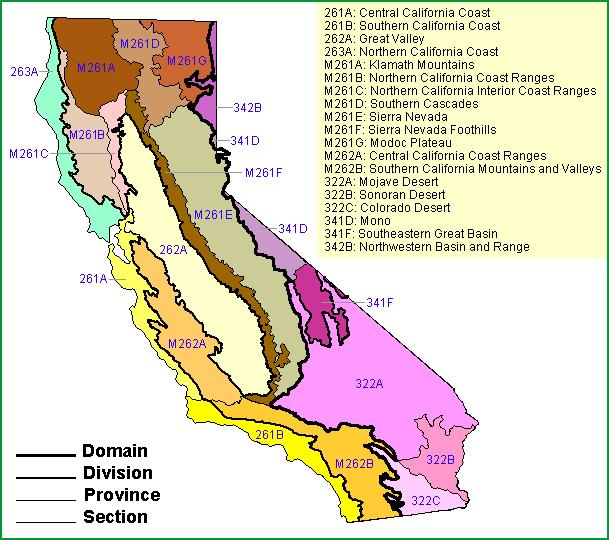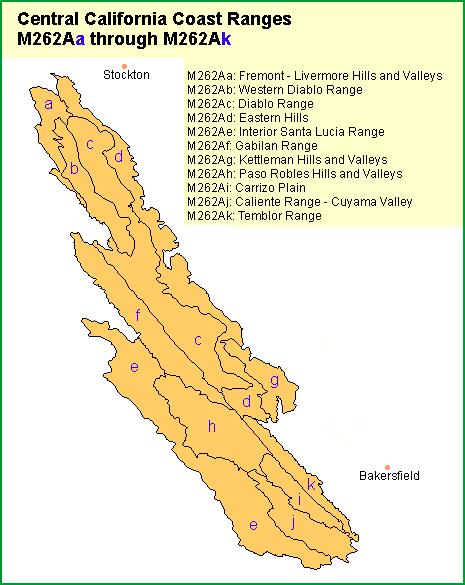 | Central California Coast Ranges |
|
|
http://www.fs.fed.us/r5/projects/ecoregions/m262a.htm
Section M262A
Central California Coast Ranges
This section is the interior part of the southern Coast Ranges of California, south of the Carquinez Strait. It is inland from the coast far enough that the climate is modified only slightly by marine influence. It is bounded on the northeast by the alluvial plain of the San Joaquin Valley and on the southwest by the coastal part of the southern Coast Ranges (Section 261A). It extends south to the Transverse Ranges. It is in MLRA 15 and includes small parts of MLRAs 14, 17, and 20.
Geomorphology. Parallel ranges, folded, faulted and metamorphosed strata; rounded crests of subequal height. Coast Ranges Geomorphic provinces.
Lithology. Cenozoic marine and nonmarine sedimentary rocks and alluvial deposits, Late Mesozoic shelf, slope and eugeosynclinal sedimentary rocks, and Mesozoic ultramafic rocks.
Soil Taxa. Alfisols, Aridisols, Entisols, Inceptisols, Mollisols and Vertisols in combination with thermic or mesic soil temperature regimes and xeric or aridic soil moisture regimes.
Vegetation. Predominant potential natural communities include the Coast Live oak series, Blue oak series, Purple needlegrass series, Chamise series, Valley oak series and mixed chaparral shrublands.
The following series are found throughout the section and are not restricted to or extensive in any subsection. Series dominated by exotic plants are not listed under subsections unless they are extensive and stable.
Series dominated by exotic plants: California annual grassland series, Cheatgrass series, Giant reed series and Tamarisk series.
Series that can occur in all subsections, but are not extensive: Beaked sedge series, Bulrush series, Bulrush - cattail series, Cattail series, Creeping ryegrass series, Duckweed series, Foothill needlegrass series, Introduced perennial grassland series, Mexican elderberry series, Mosquito fern series, Nodding needlegrass series, One-sided bluegrass series, Pondweeds with floating leaves series, Pondweeds with submerged leaves series, Purple needlegrass series. Quillwort series, Saltgrass series, Sedge series and Spikerush series.
Series restricted to riparian settings: Arroyo willow series, Buttonbush series, California sycamore series, Fremont cottonwood series, Mixed willow series, Mulefat series, Narrowleaf willow series, Red willow series and White alder series.
Fauna. Mammals include mule deer, pronghorn, tule elk, coyote, bobcat, ground squirrel and kangaroo rat. Birds include hawks, eagles, owls, quail, mourning dove, mockingbird, scrub jay, gulls, herons, crows, finches and sparrows. The California condor is being reintroduced in the southern part of the section. Introduced species include the Andean condor and feral pigs.
Elevation. 100 to 5200 feet.
Precipitation. 6 to 40 inches.
Temperature. 45░ to 65░F.
Growing Season. 120 to 275 days.
Surface Water Characteristics. Few slow and moderately slow moving rivers and streams flowing northerly to Monterey Bay via the Salinas River. Few streams in alluvial or weak bedrock channels flow directly toward the Pacific Ocean. Many streams that flow eastward in alluvial or weak bedrock channels to the Great Valley section do not flow throughout the summer. Reservoirs for irrigation and flood control are common.
Disturbance Regimes.
Fire: Fires are low, moderate or high intensity ground or stand replacing fires.
Seismic Activity: Seismically active area with strong shaking and ground rupture.
Climate: Wide fluctuations in precipitation and temperature for periods of years result in significant or catastrophic changes in biological communities.
Land Use. Composition and successional sequence of some communities has changed because of plant and animal species introduced between the mid 1800Æs and early 1900Æs related to grazing and agriculture.
Cultural Ecology. Humans have been utilizing the section for about 8,000 years, and have been an integral part of Coast Range ecology for about 2,000 years. World renown Chumash rock art is a unique reflection of prehistoric lifestyle. Grazing is an important historic use, beginning with land grants during the Mexican period. Contemporary attitudes and beliefs are dichotomized between emphasis on amenity/newcomer and commodity/long-time resident values, but all overlain by a rural lifestyle. Economic emphases are recreation, agriculture, and government.
Subsections. The Central California Coast Ranges Section is divided into 11 subsections.
Map
Fremont - Livermore Hills and Valleys-Western Diablo Range-Diablo Range
Eastern Hills-Interior Santa Lucia Range-Gabilan Range-Kettleman Hills and Valleys
Paso Robles Hills and Valleys- Carrizo Plain-Caliente Range - Cuyama Valley-Temblor Range

